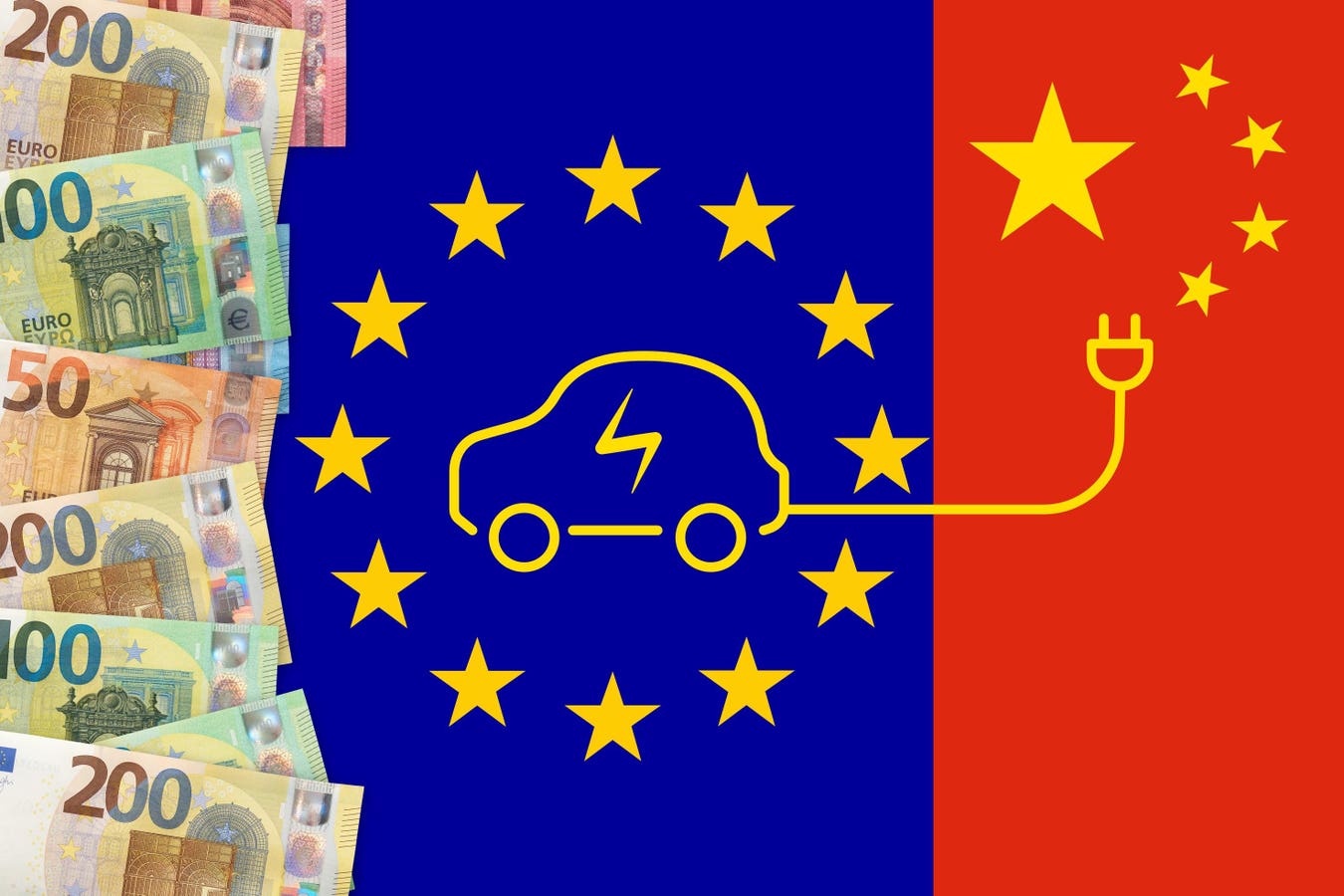Euros notes on a European union flag background.
getty
China’s plan to capture a big share of Europe’s electric vehicle market now includes much local manufacturing but the likes of BMW, Mercedes, Stellantis and Volkswagen are retaliating with a host of new model launches, according to a report.
Investment bank UBS said the IAA Mobility 2025 motor show in Munich which closed September 14 showed how ambitious China’s plans are for Europe. UBS said more than a dozen Chinese brands attended, and over 50 Chinese suppliers were there.
The report, from BMI, a subsidiary of Fitch Solutions, said Europe might be outgunned in the price war, but heritage and brand image can be a more powerful weapon.
Price might not be too important if the choice is between BMW, Mercedes, Audi and Porsche versus say Xpeng, Dongfeng, Chery or BYD. Even Volkswagen, Renault, Peugeot and Fiat might have more resonance with buyers in Western Europe than Jaecoo, Omoda, or Leapmotor, although a 30% price advantage might be crucial in favor of the Chinese.
Chinese EVs also lack the extended high-performance cruising ability to meet the 80 mph+ all-day cruising ability needed on Europe’s impressive autoroute network.
“China’s role in Europe’s autos industry is shifting from export-led growth to local manufacturing, with electric vehicle-related capacity already being built in the EU, coming online and scaling up, a trend reinforced by the EU’s tariffs on Chinese EVs introduced in 2024,” the report said.
“We contend that an extensive model launch planned for 2026-2027 by European manufacturers across internal combustion engine and EV powertrains will prove crucial to defending home-market share against intensifying competition from Chinese brands,” it said.
‘BYD Hefei,” vehicles for export to Zeebrugge Port in Belgium in Suzhou, China. (Photo by Costfoto/NurPhoto via Getty Images)
NurPhoto via Getty Images
“We also expect entrenched loyalty to heritage European brands among local buyers will constrain many Chinese brands’ ability to gain traction, particularly in Western Europe,” according to the report.
China’s Europe share almost doubles
Automotive consultants JATO Dynamics has said in the first half of 2025 the market share of Chinese brands in Europe almost doubled to 5.1%, compared with the same period of 2024, driven by BYD, Jaecoo, Omoda, Leapmotor and Xpeng. Many of these sales were EVs with some plug-in hybrids and combustion vehicles.
Dr Michael Putz, managing partner at Automodicted Consulting, recently told Forbes Chinese automakers have big ambitions for Germany, with a 10% market share a credible target.
In its report, BMI said EV and plug-in hybrid sales in Europe will rise to 5.0 million in 2027 from 3.1 million in 2024, raising market share to 30% from 19.4%. This will be propelled as well by new affordable EVs from Volkswagen, VW’s Skoda subsidiary, Renault, and Stellantis’s Peugeot and Fiat. Attracted by the burgeoning market, and the imposition of EV tariffs by the EU, several Chinese manufacturers have announced plans to build cars in Europe. BYD has plants in Hungary and Turkey, Chery is making its Omoda and Jaecoo brands in Barcelona, Spain. Stellantis affiliate Leapmotor is building vehicles in Spain, after starting assembly in Poland.
Chinese manufacturers, facing intense competition at home, are being forced to find new markets overseas. With the U.S. effectively blocked by 100% tariffs, wealthy Europe, or at least the Western bit, is a juicy target.
China has become the world’s biggest car market, but all is not well on the home market.
China’s home market in a mess
In a Special Report entitled “China is sending its world-beating auto industry into a tailspin”, Reuters said government forced production targets with no reference to demand have created a saturated market. Last year, Chinese automakers had the capacity to make twice the 27.5 million cars they made. Reuters quotes consultants AlixPartners saying by 2030 only 15 of the 129 EV and hybrid makers will be financially viable.
The Chinese electric car OMODA & JAECOO brand concept presents its models at IAA Mobility in Munich. (Photo by EyesWideOpen/Getty Images)
Getty Images
The plans to make lots more vehicles in Europe won’t please the authorities in China.
Meanwhile, BMI said among other factors, the EU’s stringent timetable to make Europeans buy only new EVs by 2035 presented China’s automakers with an irresistible target.
“As we anticipated in 2022, Europe stood out as a natural destination for Chinese EV makers seeking overseas growth, combining strong pull factors from stringent CO2 emission rules aligned with the EU’s climate goals, tightening phase-out timelines for internal combustion engine vehicles and generous EV incentives across various markets.”
“Europe presented a gap in the EV market for affordable models, as European (manufacturers) prioritized higher-margin segments such as SUVs. Additionally, the EU’s expanding charging infrastructure and high-income consumer base facilitated the entry of new Chinese EV brands, which gradually gained acceptance, built brand awareness and increased market share in the European EV market,” according to the report.
Carmakers seek dilution of EU CO2 rules
European manufacturers and politicians from car-making countries are currently negotiating with the EU to soften the race to EV-only new car sales by 2035. They want the exclusion of hybrids and plug-in hybrids rescinded, and e-fuels to be allowed, which would extend the life of combustion vehicles. The EU Commission has also called for incentives to allow European manufacturers to compete in a new entry-level EV market to stave off the Chinese threat.
Europe’s carmakers are also breathing a sigh of relief that EV sales have not kept pace with the regulations.
“We believe that the slower than expected EV transition provides incumbent (manufacturers) an adjustment period to narrow the cost and substance gap,” said HSBC Global Investment Research.
Renault 5 E-Tech (Photo by Sjoerd van der Wal/Getty Images)
Getty Images
BMI said the wave of new EVs between 2026 and 2027 include compact SUVs and hatchbacks with shorter range variants using lithium iron phosphate batteries (LFP) which cut costs and improve durability, but with the loss of some range. New choices at the bottom end of the market will include the VW ID.1 and ID.Polo, Renault 5 E-tech, Citroen e-C3, Peugeot E-208 and Fiat Panda EV.
BMI points out some possible pitfalls for European manufacturers. Consumers may find the low prices from China to be irresistible, particularly if economic weakness continues. Delays in launches wouldn’t help, while European software has to be up to the high Chinese standard, particularly in the premium sector.
Unintended consequences
“We also note trade and geopolitical risk, including tariffs or export controls, which could disrupt the EV supply chain, as illustrated by a bumpy 2025 for carmakers with higher U.S. auto tariffs and heightened risks from China’s controls on rare earth minerals exports,” the report concluded.
There are perhaps two reassuring unintended consequences of the Chinese automotive problems at home and the huge investments of its exporters abroad. Any threat to world peace from a possible invasion of Taiwan surely won’t happen any time soon because any military activity would bring all these ambitions export plans to a halt, at least in Europe. Similarly, a fresh Russian incursion into Ukraine would bring China’s hugely expensive and ambitious plans for Europe to a screeching halt as buyers recoiled.









